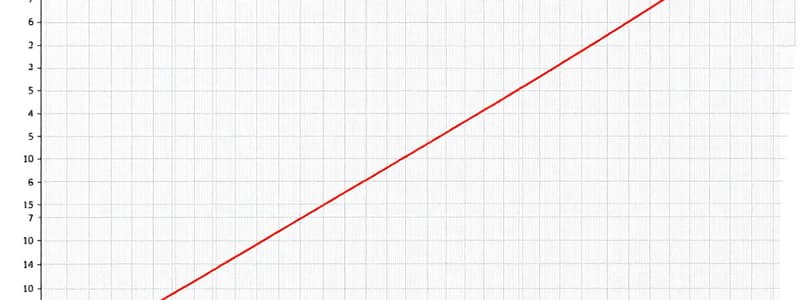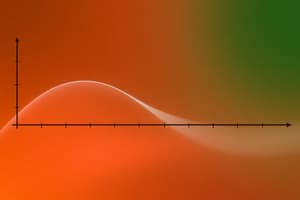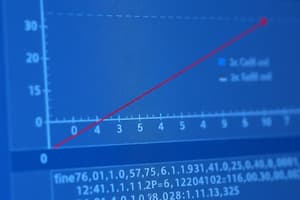Podcast
Questions and Answers
In a multiple linear regression, which of the following statements is correct?
In a multiple linear regression, which of the following statements is correct?
- It involves only two variables: one dependent and one independent.
- It involves multiple dependent variables and a single independent variable.
- It involves only two independent variables and one dependent variable.
- It involves one dependent variable and multiple independent variables. (correct)
In the equation poverty = 11.17 + 0.38 × west, if 'west' is 0 for eastern states and 1 for western states, how is the value 11.17 interpreted?
In the equation poverty = 11.17 + 0.38 × west, if 'west' is 0 for eastern states and 1 for western states, how is the value 11.17 interpreted?
- It's the value needed to get when plugging in 1 for the explanatory variable.
- It's the estimated average poverty percentage in eastern states. (correct)
- It's the increase in poverty percentage when moving from an eastern to a western state.
- It's the estimated average poverty percentage in western states.
Using the poverty vs. region example, if the regression model is: poverty = 9.50 + 0.03midwest + 1.79west + 4.16*south, and Northeast is the reference level, what does the 4.16 coefficient for the South region represent?
Using the poverty vs. region example, if the regression model is: poverty = 9.50 + 0.03midwest + 1.79west + 4.16*south, and Northeast is the reference level, what does the 4.16 coefficient for the South region represent?
- The difference in average poverty percentage between the South and the combined average of other regions.
- The average poverty percentage in the Northeast.
- The average poverty percentage in the South.
- The difference in average poverty percentage between the South and the Northeast. (correct)
Given the regression output for poverty vs. region (northeast, midwest, west, south), what does the intercept represent?
Given the regression output for poverty vs. region (northeast, midwest, west, south), what does the intercept represent?
Given a scatterplot showing the relationship between the weights and volumes of books, along with a regression output of weight = 108 + 0.7volume with $R^2 = 80%$, what is the best interpretation of the value 0.7?
Given a scatterplot showing the relationship between the weights and volumes of books, along with a regression output of weight = 108 + 0.7volume with $R^2 = 80%$, what is the best interpretation of the value 0.7?
Given the regression output of weight = 108 + 0.7volume with $R^2 = 80%$, what is the best interpretation of the $R^2$ value?
Given the regression output of weight = 108 + 0.7volume with $R^2 = 80%$, what is the best interpretation of the $R^2$ value?
Given a scenario where the relationship between book weight and volume is being analyzed, with a scatterplot showing hardcover and paperback books, and the regression output is weight = 197.96 + 0.72*volume - 184.05*cover:pb, how would you estimate the weight of paperback books?
Given a scenario where the relationship between book weight and volume is being analyzed, with a scatterplot showing hardcover and paperback books, and the regression output is weight = 197.96 + 0.72*volume - 184.05*cover:pb, how would you estimate the weight of paperback books?
Based on the regression output: weight = 197.96 + 0.72*volume - 184.05*cover:pb, with 'cover:pb' indicating paperback, how would you calculate the predicted weight for hardcover books?
Based on the regression output: weight = 197.96 + 0.72*volume - 184.05*cover:pb, with 'cover:pb' indicating paperback, how would you calculate the predicted weight for hardcover books?
Based on the regression output, if cover:pb represents paperback, which type of book cover is the reference level?
Based on the regression output, if cover:pb represents paperback, which type of book cover is the reference level?
Given the regression equation weight = 197.96 + 0.72*volume - 184.05*cover:pb, which variable is the response variable?
Given the regression equation weight = 197.96 + 0.72*volume - 184.05*cover:pb, which variable is the response variable?
Using the regression output, calculate the predicted weight of a paperback book with a volume of 600 cm³.
Using the regression output, calculate the predicted weight of a paperback book with a volume of 600 cm³.
In the regression analysis of kid's test scores, what does the slope for mom's IQ represent?
In the regression analysis of kid's test scores, what does the slope for mom's IQ represent?
In the output relating kid's test scores to characteristics of their mothers, the intercept value represents
In the output relating kid's test scores to characteristics of their mothers, the intercept value represents
In the context of multiple regression, collinearity refers to:
In the context of multiple regression, collinearity refers to:
What is the primary reason for calculating adjusted $R^2$ in multiple regression?
What is the primary reason for calculating adjusted $R^2$ in multiple regression?
In predicting poverty using '% female hh' (female householder) and '% white', what does the coefficient for female_house represents?
In predicting poverty using '% female hh' (female householder) and '% white', what does the coefficient for female_house represents?
In the equation weight = 11.17 + 0.38 × west, if 'west' is 0 for states to the east and 1 for states to the west, how is the value 0.38 interpreted?
In the equation weight = 11.17 + 0.38 × west, if 'west' is 0 for states to the east and 1 for states to the west, how is the value 0.38 interpreted?
In the regression equation for kid's test scores including mom's characteristics, what is the reference level?
In the regression equation for kid's test scores including mom's characteristics, what is the reference level?
In a regression equation, multicollinearity arises when:
In a regression equation, multicollinearity arises when:
We do not like multicollinearity because it:
We do not like multicollinearity because it:
Why would adjusted $R^2$ be used in place of $R^2$?
Why would adjusted $R^2$ be used in place of $R^2$?
Given a model for weight and volume of book has an adjusted and normal $R^2$, which linear model do you pick?
Given a model for weight and volume of book has an adjusted and normal $R^2$, which linear model do you pick?
The adjusted $R^2$ can be calculated with
The adjusted $R^2$ can be calculated with
With respect to categorical variables, the baseline is
With respect to categorical variables, the baseline is
With respect to the slopes of categorical variables, the level can be interpreted as
With respect to the slopes of categorical variables, the level can be interpreted as
The regression result for moms who did had a HS education is statistically important, according to:
The regression result for moms who did had a HS education is statistically important, according to:
In the case of the kids scores depending of their mothers, the independent variables are
In the case of the kids scores depending of their mothers, the independent variables are
In the linear equation, the y-parameter shift is attributed to
In the linear equation, the y-parameter shift is attributed to
When thinking about multi-collinearity, we want the variables to be
When thinking about multi-collinearity, we want the variables to be
Which of the following statements is the most accurate regarding the relationship between $R^2$ and adjusted $R^2$?
Which of the following statements is the most accurate regarding the relationship between $R^2$ and adjusted $R^2$?
You create a model using one indepedent variable that comes back with R^2 = 0.4, but the P-value is 0.15 and another indepedent variable is P value = 0.001
You create a model using one indepedent variable that comes back with R^2 = 0.4, but the P-value is 0.15 and another indepedent variable is P value = 0.001
You add female as a variable - poverty line % has r squared of 0.8 but adjusted of 0.6 using 50 datasets what does this mean?
You add female as a variable - poverty line % has r squared of 0.8 but adjusted of 0.6 using 50 datasets what does this mean?
If SSTotal represents the total sum of squares, and SSError represents the sum of squares due to error, the regression model can be determined by
If SSTotal represents the total sum of squares, and SSError represents the sum of squares due to error, the regression model can be determined by
With respect to OLS (ordinary regressions), higher value is associated with a model
With respect to OLS (ordinary regressions), higher value is associated with a model
The coefficient b_1 refers to
The coefficient b_1 refers to
A reason why a predictor variable may not be a good tool to make conclusions:
A reason why a predictor variable may not be a good tool to make conclusions:
In a multiple regression model predicting book weight based on volume and cover type (hardcover/paperback), how would you interpret a statistically significant negative coefficient for the 'cover:paperback' variable?
In a multiple regression model predicting book weight based on volume and cover type (hardcover/paperback), how would you interpret a statistically significant negative coefficient for the 'cover:paperback' variable?
If a multiple regression model predicting poverty includes '% female householder' and '% white' as predictors, and multicollinearity exists between these predictors, what is a likely consequence?
If a multiple regression model predicting poverty includes '% female householder' and '% white' as predictors, and multicollinearity exists between these predictors, what is a likely consequence?
When building a multiple regression model, you observe that adding a new predictor variable increases the $R^2$ value, but the adjusted $R^2$ decreases. What does this suggest?
When building a multiple regression model, you observe that adding a new predictor variable increases the $R^2$ value, but the adjusted $R^2$ decreases. What does this suggest?
You are building a multiple regression model. Which of the following scenarios indicates a potential issue of multicollinearity among the predictor variables?
You are building a multiple regression model. Which of the following scenarios indicates a potential issue of multicollinearity among the predictor variables?
Suppose you're modeling poverty rates across different regions of a country, using Northeast as the reference level. If the coefficient for the 'South' region is 4.16, this indicates:
Suppose you're modeling poverty rates across different regions of a country, using Northeast as the reference level. If the coefficient for the 'South' region is 4.16, this indicates:
In a regression model analyzing kids' test scores based on characteristics of their mothers, the intercept represents the predicted test score for a child:
In a regression model analyzing kids' test scores based on characteristics of their mothers, the intercept represents the predicted test score for a child:
In predicting poverty using '% female householder' and '% white', what does a statistically significant coefficient for '% female householder' suggest?
In predicting poverty using '% female householder' and '% white', what does a statistically significant coefficient for '% female householder' suggest?
In the equation weight = 197.96 + 0.72 × volume - 184.05 × cover:pb, what does the coefficient -184.05 associated with 'cover:pb' represent?
In the equation weight = 197.96 + 0.72 × volume - 184.05 × cover:pb, what does the coefficient -184.05 associated with 'cover:pb' represent?
You are comparing two multiple regression models: Model A has 3 predictors and an $R^2$ of 0.65, while Model B has 5 predictors and an $R^2$ of 0.70. To determine which model provides a better balance between fit and complexity, which metric should you primarily consider?
You are comparing two multiple regression models: Model A has 3 predictors and an $R^2$ of 0.65, while Model B has 5 predictors and an $R^2$ of 0.70. To determine which model provides a better balance between fit and complexity, which metric should you primarily consider?
In a multiple regression model where you are trying to determine the factors influencing a child's test score. Considering the equation is: test_score = 19.59 + 5.09mom_hs + 0.56mom_iq + 2.54mom_work + 0.22mom_age. If Mom's IQ increases by 10 points, how would this affect the child's test score?
In a multiple regression model where you are trying to determine the factors influencing a child's test score. Considering the equation is: test_score = 19.59 + 5.09mom_hs + 0.56mom_iq + 2.54mom_work + 0.22mom_age. If Mom's IQ increases by 10 points, how would this affect the child's test score?
Flashcards
Multiple Linear Regression
Multiple Linear Regression
Regression using multiple variables to predict an outcome.
Regression Intercept
Regression Intercept
The estimated average poverty percentage in the reference category.
Intercept Value
Intercept Value
Value obtained when the explanatory variable is set to 0.
Regression Slope
Regression Slope
Signup and view all the flashcards
ANOVA in Regression
ANOVA in Regression
Signup and view all the flashcards
Collinearity
Collinearity
Signup and view all the flashcards
Adjusted R-squared
Adjusted R-squared
Signup and view all the flashcards
Explanatory variables
Explanatory variables
Signup and view all the flashcards
R
R
Signup and view all the flashcards
R-squared
R-squared
Signup and view all the flashcards
Study Notes
Introduction to Multiple Regression
- Simple linear regression involves two variables: y and x
- Multiple linear regression involves multiple variables: y, x1, x2, etc.
Poverty vs. Region (East, West)
- Explanatory variable being the region
- The reference level is East
- Intercept represents the estimated average poverty percentage in eastern states, which is 11.17%
- Plugging in 0 for the explanatory variable yields the intercept value
- Slope indicates the average poverty percentage in western states is 0.38% higher than in eastern states
- Calculating the poverty percentage in western states: 11.17 + 0.38 = 11.55%
- Plugging in 1 for the explanatory variable gives the value for western states
Poverty vs. Region (Northeast, Midwest, West, South)
- If Northeast is the reference level then Northeast has the lowest poverty percentage
Weights of Books
- Scatterplots can show the correlation between weights and volumes of books
- When considering regression output, knowing that books 10 cm³ over average are expected to weigh 7g over average, is most factual
Modeling Weights of Books Using Volume
- The equation is derived from regression analyses with an R-squared of 0.8026 and an adjusted R-squared of 0.7875
- F-statistic: 52.87, p-value: 6.262e-06
Weights of Hardcover and Paperback Books
- Paperbacks typically weigh less than hardcover books when controlling for volume
Modeling Weights of Books Using Volume and Cover Type
- Coefficients: Intercept is 197.96284, Volume is 0.71795, Cover:pb is -184.04727
- Residual standard error: 78.2
- The R-squared is 0.9275, and the adjusted R-squared is 0.9154
- F-statistic is 76.73 with a p-value of 1.455e-07
Determining the Reference Level
- Hardcover is reference level when pb = paperback
- Weight is the response variable, while volume and cover type are explanatory variables
Linear Model
- The estimated values: Intercept is 197.96, volume is 0.72, coverpb is -184.05.
- Hardcover books: weight = 197.96 + 0.72volume - 184.05*0 = 197.96 + 0.72volume
Visualizing the linear model
- Graphs can show hardcover and paperback books in correlation to weight vs volume
Linear Model Slopes
- For every additional cubic centimeter in volume, a book tends to weigh 0.72 grams more, all else being equal
- Paperback books are predicted to weigh 184 grams less than hardcover books
- Hardcover books with no volume are expected to weigh 198 grams which adjusts the regression line
Prediction
- To calculate the predicted weight of a paperback book with a volume of 600 cm³, the following should be calculated: 197.96 + 0.72 * 600 - 184.05 * 1
Another Example: Modeling Kid's Test Scores
- Characteristics of mothers are used to predict the cognitive test scores of their children
Interpreting the Slope
- Kids tend to score 0.56 points higher with every one point increase in their mothers IQ, all other factors being constant
Interpreting the Intercept
- Children whose moms haven't gone to to high school would average a score of 19.59
Interpreting the Slope of Mother's Work
- Children whose moms worked during the first three years of their lives will score 2.54 points higher all things being equal.
Revisit: Modeling Poverty
- Modeling poverty using metro residence, white, hs grad, female house
Another Look at R²
- R² calculates
- The square of the correlation coefficient of x and y
- The square of the correlation coefficient of y and ŷ
- Ratio of explained variability in y to total variability in y
- ANOVA calculates the explained variability and total variability in y
Sum of Squares
- Total variability = ∑(y - y)² = 480.25
- Unexplained variability = ∑ei2 = 347.68
- Explained variability is SSTotal - SSError = 480.25 – 347.68 = 132.57
- R² = explained variability / total variability = 132.57 / 480.25 = 0.28
Why Bother?
- Single-predictor linear regression may seem overkill
- Multiple linear regression cannot calculate R² as the square of the correlation between x and y
- Adjusted R² is a measure of explained variability
Predicting Poverty using % Female hh + % White
- Linear Model: (Intercept) -2.58, female_house 0.89, white 0.04
Collinearity Between Explanatory Variables
- Two predictor variables are collinear when they are correlated, which complicates model estimation
- Predictors are also called explanatory or independent variables, which are generally independent of each other
R² vs. Adjusted R²
- Any added variable in the model R² increases
- Adjusted R² does not see change
- Adjust R adj2 will lower when p is adjusted in the model
- Models high in RA2 should be chosen
Calculate Adjusted R²
- AdjR2 can be calculated as such where SSTotal = 480.25, and SSError = 339.47: = 1- (339.47/480.25) * ((51-1)/(51-2-1)) = 0.26
Studying That Suits You
Use AI to generate personalized quizzes and flashcards to suit your learning preferences.




